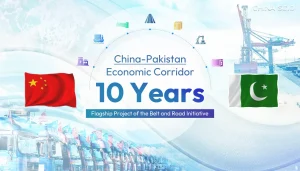Ambassador Khalid Mahmood, Chairman Board of Governors, Institute of Strategic Studies Islamabad (ISSI)
The $62 billion China Pakistan Economic Corridor (CPEC) announced in 2013 during Chinese Premier’s visit to Pakistan and inaugurated when President Xi Jinping paid a visit to Pakistan in 2015 is veritably a path-breaking development which put Pak-China historically tested friendly relations on the path to greater integration across diverse fields in the bilateral and regional framework and beyond. As we mark the 10th anniversary of this consequential initiative, it is an opportune time to evaluate its progress, identifying the challenges which need to be addressed in a timely manner.
CPEC is not an isolated phenomenon. It is kernel of the much wider vision embodied in the $1.4 trillion Belt and Road Initiative ( BRI) whose ambit covers almost the whole globe with the objective of universal socio economic- cum- cultural development, connectivity and integration for the common good. CPEC has rightly been described as the ‘flagship project’ of BRI as the experience of CPEC would leave a direct impact on the outcome of BRI.
CPEC holds special relevance to the Pak-China bilateral relationship. It is axiomatic to say that this relationship, anchored in the Five Principles of Co-existence and enjoying popular support among peoples of the two countries, has stood the test of time irrespective of many a domestic and external changes. It is also a fact that hitherto this otherwise precious bond had largely been confined to strategic, security and defence fields. Bilateral commercial ties and economic cooperation were not commensurate with the depth and closeness of this relationship. People-to-people contacts were also scanty. CPEC is an attempt to rectify these two lacunae in the Pak-China bilateral relations.

CPEC, successfully overcoming the teething problems, has been making steady progress. In the first phase, it rightly addressed the bane of energy shortages and inadequate infrastructure. By all accounts, CPEC has acquitted itself well in these priority areas. Forty seven projects have been started or completed with a total investment of more than $25 billion opening up 150000 job opportunities. Now as CPEC enters the second phase, the stage is set to embark on projects in the fields of commerce, industry, agriculture, science and technology transfer. In this regard the early establishment of Special Economic Zones (SEZs) is being pursued vigorously. The earlier these Zones, equipped with all the necessary enabling facilities, become operational the better.
While persevering in our strong political commitment to CPEC, prudence demands that we should not be oblivious of the various challenges facing it. Some challenges merit special mention. Provision of adequate security and safety of the installations and the workforce, Chinese and Pakistanis, deployed there must be ensured. Secondly, considering that important CPEC projects are located in areas which are relatively less developed, care has to be exercised to ensure that the local people are among the primary beneficiaries. Marginalizing local population runs the danger of fanning sub-nationalist and terrorism forces. Thirdly, in order to partake in a meaningful manner in the various projects we need to step up our capacity building efforts through appropriate vocational training programmes.
Notably, CPEC also faces external danger. India as well as USA and other western countries generally, in varying degree, have expressed their opposition to it. They view CPEC more through a self-serving geo-political lens and the endemic India -Pakistan inimical ties. Both China and Pakistan have to be watchful of any external mischief to undermine CPEC. It would have been for the good of one and all, had these countries instead looked at CPEC as an economic project, which essentially it is.
In order to undermine CPEC and more broadly BRI, the Western countries are pedaling the scare that these projects would lead to “debt trap” for the developing participating countries. There could be nothing more far off from the truth. In any case their altruistic approach would rather call for their own participation in these projects through enhanced investment and technology transfer. It would be worth recalling that China poured in investment through CPEC in Pakistan at a time when no other country was inclined to touch Pakistan with a barge pole.
CPEC is not exclusionary in nature. It is open to all. Already Afghanistan, Central Asian states, Iran and other Persian Gulf countries have shown their interest to join. This trend is likely to further pick up following the wind of conciliation and cooperation lately sweeping the region. Of course, early return of peace and stabilization in Afghanistan is crucial in this regard.
CPEC is an important component of the triple Chinese grand Initiatives encompassing Global Development Initiative (GDI), Global Security Initiative (GSI) and Global Civilizational Initiative (GCI). Its materialization would reinforce those grand initiatives helping to promote socio-economic development, peace, prosperity and mutual understanding in the world.
CPEC is a humongous project which will have a far-reaching impact on not only further bolstering the unique Pakistan-China bilateral relationship, but also bring prosperity to the other regional countries through accelerated development and enhanced connectivity. Cognizant of the various internal and external challenges and threats, Pakistan in collaboration with China and other like-minded countries have to stay the course and mobilize all their resources and capabilities towards the earliest realization of CPEC. Its success would be a telling repudiation of its naysayers, both internal and external. So let us celebrate the Decade of CPEC, reaffirming our unwavering commitment to it and work for its high quality accelerated implementation. Long live Pakistan-China ironclad friendship!










